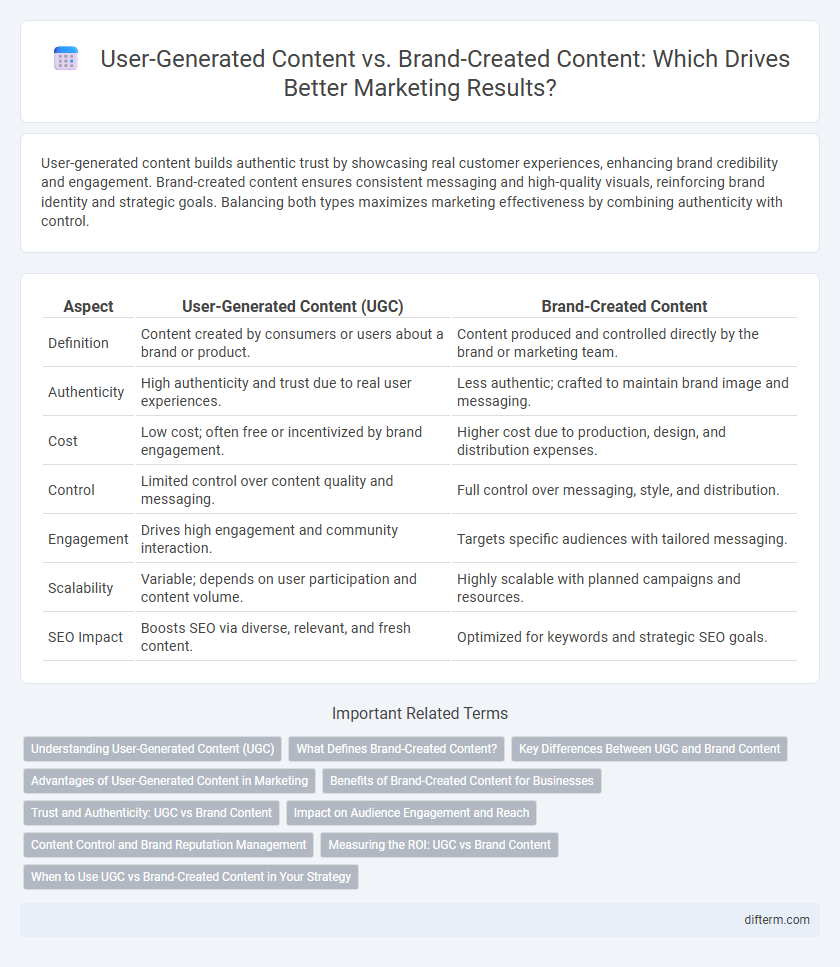User-generated content builds authentic trust by showcasing real customer experiences, enhancing brand credibility and engagement. Brand-created content ensures consistent messaging and high-quality visuals, reinforcing brand identity and strategic goals. Balancing both types maximizes marketing effectiveness by combining authenticity with control.
Table of Comparison
| Aspect | User-Generated Content (UGC) | Brand-Created Content |
|---|---|---|
| Definition | Content created by consumers or users about a brand or product. | Content produced and controlled directly by the brand or marketing team. |
| Authenticity | High authenticity and trust due to real user experiences. | Less authentic; crafted to maintain brand image and messaging. |
| Cost | Low cost; often free or incentivized by brand engagement. | Higher cost due to production, design, and distribution expenses. |
| Control | Limited control over content quality and messaging. | Full control over messaging, style, and distribution. |
| Engagement | Drives high engagement and community interaction. | Targets specific audiences with tailored messaging. |
| Scalability | Variable; depends on user participation and content volume. | Highly scalable with planned campaigns and resources. |
| SEO Impact | Boosts SEO via diverse, relevant, and fresh content. | Optimized for keywords and strategic SEO goals. |
Understanding User-Generated Content (UGC)
User-Generated Content (UGC) is authentic content created by customers or users that promotes a brand's products or services through reviews, photos, videos, and social media posts. UGC drives higher engagement, builds trust, and enhances brand credibility by showcasing real experiences and diverse perspectives from actual consumers. Leveraging UGC strategically can significantly boost organic reach and influence purchasing decisions more effectively than traditional brand-created content.
What Defines Brand-Created Content?
Brand-created content is defined by its origin within a company, crafted by internal teams or hired agencies to strategically align with brand messaging and marketing goals. It typically includes polished advertisements, official social media posts, blog articles, and product videos designed to maintain consistent brand voice and visual identity. This controlled approach ensures accuracy, promotes key values, and drives targeted customer engagement through carefully curated storytelling.
Key Differences Between UGC and Brand Content
User-Generated Content (UGC) differs from Brand-Created Content primarily in authenticity and audience engagement, as UGC is produced by customers and reflects genuine experiences, boosting trust and loyalty. Brand content is strategically designed by companies to maintain consistent messaging and showcase product features, ensuring brand control and positioning. UGC typically drives higher social proof and organic reach, while brand content excels in delivering polished narratives aligned with marketing objectives.
Advantages of User-Generated Content in Marketing
User-generated content (UGC) enhances brand authenticity by showcasing genuine customer experiences, increasing trust and engagement. UGC drives higher conversion rates as potential buyers relate more to peer-generated reviews and visuals than traditional ads. Marketers benefit from cost-effective content creation while expanding reach through organic social sharing and community participation.
Benefits of Brand-Created Content for Businesses
Brand-created content allows businesses to maintain complete control over messaging, ensuring consistent brand identity and tone across all platforms. It provides the opportunity to strategically highlight unique selling points, tailored campaigns, and precise calls-to-action that drive specific marketing objectives. Investing in professional brand-created content enhances credibility, fosters trust with the target audience, and supports long-term brand equity growth.
Trust and Authenticity: UGC vs Brand Content
User-generated content (UGC) consistently outperforms brand-created content in building trust and authenticity among consumers due to its genuine, peer-driven nature. Studies show that 79% of consumers trust UGC more than traditional advertising, as it provides relatable and unbiased experiences. Incorporating UGC into marketing strategies enhances credibility and fosters deeper emotional connections with target audiences compared to polished, brand-produced messages.
Impact on Audience Engagement and Reach
User-Generated Content (UGC) consistently drives higher audience engagement by fostering authentic connections and trust, as consumers perceive it as more relatable and credible than Brand-Created Content. Brands leveraging UGC experience increased reach through organic sharing and social proof, amplifying their message beyond traditional advertising limits. Conversely, Brand-Created Content allows for strategic control over messaging and aesthetics, but often sees lower engagement rates compared to the dynamic interaction UGC generates.
Content Control and Brand Reputation Management
User-generated content offers authentic engagement but presents challenges in maintaining strict content control, increasing risks for brand reputation. Brand-created content enables precise messaging and consistent brand image, ensuring reputation management remains streamlined. Balancing both strategies effectively supports credibility while safeguarding brand integrity in marketing campaigns.
Measuring the ROI: UGC vs Brand Content
Measuring the ROI of User-Generated Content (UGC) versus Brand-Created Content requires analyzing engagement metrics, conversion rates, and cost efficiency. UGC often shows higher authenticity and trust, leading to increased customer loyalty and lower content production costs compared to brand-created content. Brand content, while costly, allows precise messaging control and can drive targeted campaigns with consistent brand identity.
When to Use UGC vs Brand-Created Content in Your Strategy
User-generated content (UGC) excels in building trust and social proof by showcasing authentic customer experiences, making it ideal for awareness and consideration stages. Brand-created content delivers controlled messaging and polished visuals, better suited for product launches, promotions, and reinforcing brand identity. Integrating UGC during engagement phases and leveraging brand-created content for targeted campaigns optimizes marketing strategies for higher conversion rates.
User-Generated Content vs Brand-Created Content Infographic

 difterm.com
difterm.com